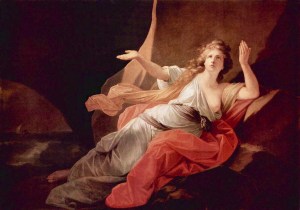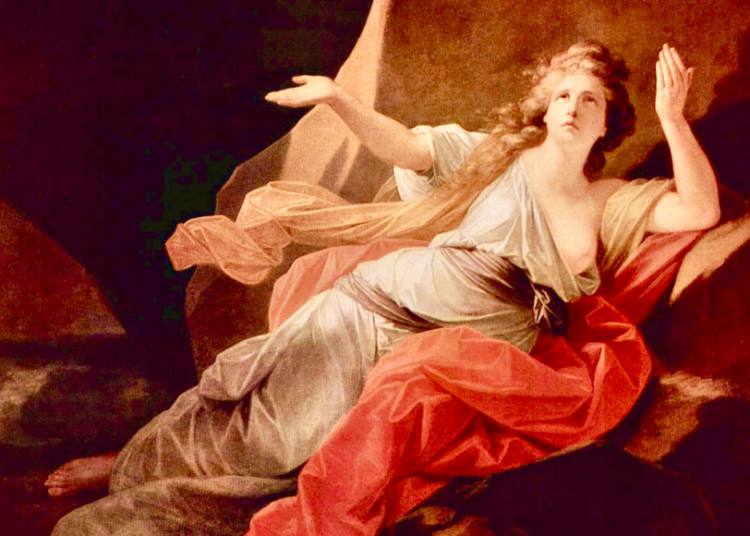“They are finally going to play my music.” —Hector Berlioz, on his deathbed
 Though Hector Berlioz’s operas are still little known today—even to the opera-going public, who are much more likely to find the dramas of Verdi, Puccini, Bellini, and Mozart on the program—the increasing recognition of their many glories is slowly making them less rare on stages across the world as we approach the third decade of the twenty-first century.
Though Hector Berlioz’s operas are still little known today—even to the opera-going public, who are much more likely to find the dramas of Verdi, Puccini, Bellini, and Mozart on the program—the increasing recognition of their many glories is slowly making them less rare on stages across the world as we approach the third decade of the twenty-first century.
The son of an atheistic father and a Roman Catholic mother, Hector Berlioz’s oeuvre often reflects this dual religious heritage. Though he composed a monumental Requiem Mass and the charming religious oratorio, L’Enfance du Christ, he mocked Christianity in conversation with others and in his Memoirs, and in several works celebrated Man seemingly at the expense of God. One thinks of the Symphonie Fantastique and its sequel, Lelio, or the Return to Life, where God is no where to be found amidst a tale of obsession, opium-use, murder, and resurrection through the force of Man’s Will; or the Byronic wanderings of the protagonist of that unique symphony with viola obligato, Harold in Italy.
Perhaps more than these works, it was in the first of his three surviving, completed operas, Benvenuto Cellini, that Berlioz’s secular version of humanism blazes most defiantly. Cellini tells the tale of the eponymous Renaissance artist who fashioned the great statue of Perseus cutting off the head of Medusa. Cellini is clearly a guise for Berlioz himself: an artist who overcomes all obstacles, including those posed by the Church (Pope Clement VII appears as an antagonist in the opera) to find his true love, prove his superiority to his peers, and demonstrate that man is indeed the measure of all things. Premiered in 1838, the opera was a failure, and for more than 100 years after the composer’s death it lay unperformed, until revived and recorded by the British conductor, Sir Colin Davis in 1972. Berlioz, however, considered the piece one of his supreme achievements: “I swear I shall never again achieve this verve and Cellinian impetuosity nor such variety of ideas.” Whether or not Berlioz was right, Benvenuto Cellini is an even more astounding achievement when one considers that it is the composer’s first foray into the genre of opera.
Below is the beautiful trio, “O mon bonheur, vous que j’aime” in which the lovers Cellini and Teresa express their mutual love and plan their escape together, with interruptions from the conniving Fieramosca, the pope’s favored sculptor and a rival for Teresa’s hand.
Based on Virgil’s epic poem the Aeneid, Hector Berlioz composed his four-hour Les Troyens in the style of French Grand Opera. Written between 1856 and 1858, the opera was not staged in its entirety during Berlioz’s lifetime, partly due to the expense of staging a work with so many leading roles and with a libretto that called for spectacular sets and special effects. Too, Berlioz—always a controversial figure in the musical world—was not known as an opera composer (indeed, his name was left off some advertisements for his previous effort in the genre, Benvenuto Cellini). In 1863, the second half of the opera, with some parts cut, was premiered under the title Les Troyens à Carthage and met with some success. But it was not until 1890, twenty-one years after the composer’s death, that the full opera was produced on stage, and it was not until 1969 that a recording of the complete piece was made (under the direction of Sir Colin Davis). And only in the early twenty-first century, when a DVD production conducted by John Eliot Gardiner was released, did critics and opera houses begin to recognize Les Troyens as one of the greatest operas of them all. “One wonders why this work is so underrated,” one critic writes. “When the opera reaches its last half an hour, starting with Aeneas’s departure for Rome, Dido’s rage, curses, misery, sudden accesses of calm, fresh outbursts, calm acceptance of utter loss and, the final doomed realization of Rome’s triumph—one finds oneself on a level that shuns most other opera’s attempts at classical transcendence.”
Here is the Dido’s lament for the downfall of Carthage, “Farewell, proud city”:
And here is the chorus, “Gloire à Didon”:
Written between 1860 and 1862, Berlioz’s opera Béatrice et Bénédict, with a libretto by the composer based on Shakespeare’s Much Ado About Nothing, was the composer’s last work. In contrast to the grand opera style of Les Troyens, written a few years before, Béatrice et Bénédict is, in Berlioz’s words, “a caprice written with the point of a needle.” It was almost as if Berlioz was defying his critics, who caricatured his orchestration as bombastic and the emotional content of his pieces as overwrought. “The music displays more clearly than any other work Berlioz’s delicate, filigree orchestral technique,” biographer Hugh Macdonald writes. Here is a light-hearted frolic, tinged with poignancy, in the spirit of Mozart’s opera buffa. As might be surmised from the opera’s title, Berlioz focused on the relationship between the play’s main characters, eliminating several subplots and simplifying other characters. The opera, which lasts about two hours, is in two acts, and intersperses arias and ensembles with spoken dialogue. “The work is difficult to perform well, the men’s roles especially,” Berlioz wrote. “To my mind it is one of the liveliest and most original things I have done.” Indeed, the opera is replete with delights. Here is one of them:
It should be noted that in addition to these three, great, completed, surviving operas, Berlioz also worked on other stage dramas, some of which never got past the planning stage. Here will be discussed only those for which he wrote music. The first, Estelle et Némorin, Berlioz started sketching at the age of twenty; how far he got is unknown, since no music from the opera survives. Around this time, he also composed an oratorio, Le Passage de la mer Rouge (The Crossing of the Red Sea), which has also been lost. Next, in 1826, he wrote a three-act opera Les francs-juges (The Free Judges), based on a libretto by his friend Humbert Ferrand, and dealing with the secret Vehmic courts of the later Middle Ages. The story certainly fired Berlioz’s imagination, dealing as it did with the themes of human freedom and oppression. Though Berlioz revised the opera twice, he was never able to have it staged; Berlioz destroyed much of the score, and today only four complete numbers survive. Berlioz did preserve the outstanding overture, which he performed often during his lifetime. In 1841, Berlioz began work on La Nonne sanglante (The Bleeding Nun), a ghost story, with a libretto by Eugène Scribe based on Matthew Lewis’ novel The Monk. Berlioz finished at least the first act but lost interest in the project, which was eventually passed to fellow French composer Charles Gounod. Today some music from the opera survives, though one can sense that the story did not bring out the best in Berlioz.
Finally, Berlioz’s La Damnation de Faust should be mentioned here.* This composition began life in 1827 as Eight Scenes from Faust before Berlioz returned to it in 1846, expanding it into a two-hour drama. Based on Johann Goethe’s famous legend, Berlioz wrote most of the libretto of Faust himself, “without attempting to translate or even imitate Goethe’s masterpiece, but only to draw inspiration from it and to extract the musical substance that it contained.” Like many of Berlioz’s major compositions, The Damnation of Faust‘s structure defies routine categorization. Featuring only three main characters, and being too episodic in its storyline and too spectacular in its visual conception to be easily staged, it does not meet the typical requirements of opera. Yet Berlioz did not call the piece a symphony, as he had with his similarly large-scale “symphonie dramatique,” Roméo et Juliette (1839), which too featured a chorus and solo voices representing characters in the story. He first deemed Faust a “concert opera” and finally a “légende dramatique.” Years later, Berlioz considered expanding the work into a full-fledged opera, but that project never came to fruition.
Since Berlioz’s death, Faust has been given both as a concert performance and as a staged dramatic work, the latter most successfully by the Metropolitan Opera in its 2008 production. Though the work’s spirit is one of unrelenting melancholy, it features much musical diversity: the jauntiness of soldiers’ marches and students’ choruses, the suave and seductive music of Mephistopheles, two sublime arias sung by Marguerite (“D’amour l’ardente flamme” is often featured in soprano recitals), and the absolutely chilling sounds of the Ride to the Abyss. Indeed, Faust is kaleidoscopic, even cinematic, in its vision. The listener here again recognizes the stunning modernism of Berlioz and finds himself immersed in the unique sound-world of the composer’s imagination.
“I consider this to be one of my best works,” Berlioz wrote of Faust in his Memoirs. And a century-and-a-half after the composer’s death, we can certainly agree with his assessment. We can also recognize as justified the pride he felt in the accomplishments of Benvenuto Cellini, Les Troyens, and Béatrice et Bénédict, three works that we can only hope will more and more frequently grace the stages of opera houses everywhere.
*See the author’s full-length essay on La Damnation de Faust here.
This is part of a series of essays commemorating the 150th anniversary of the death of Hector Berlioz.
This essay was first published here in March 2019.
The Imaginative Conservative applies the principle of appreciation to the discussion of culture and politics—we approach dialogue with magnanimity rather than with mere civility. Will you help us remain a refreshing oasis in the increasingly contentious arena of modern discourse? Please consider donating now.
The featured image is “The death of Dido” (1792) by the German painter, Heinrich Friedrich Füger, and is in the public domain, courtesy of Wikimedia Commons.


